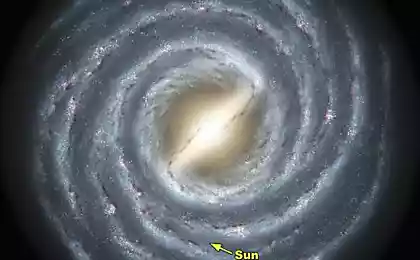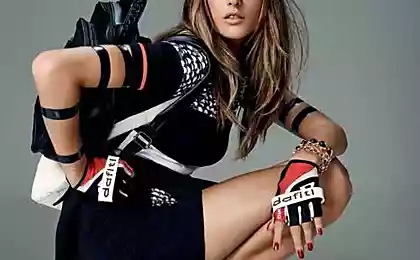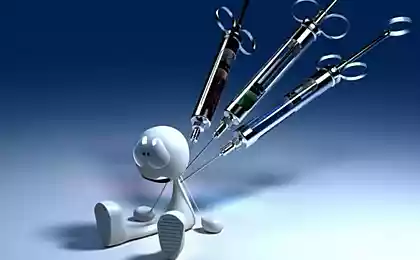502
Data collected by "Voyager-2", is still helping scientists explore the Solar system

Uranus, as seen by "Voyager 2" in 1986 (source: NASA/JPL-Caltech)
"Voyager 2" flew past Uranium 30 years ago, collecting data about the planet and its satellites. The information transmitted by the probe to earth, is still relevant: scientists make discoveries based on these data. Astronomers from the University of Idaho suggest that the gas giant may be two small satellites, which to date have escaped detection by astronomers. The fact that these two tiny moon may be hiding in two rings of Uranus, which complicates their detection.
Rob Cansia (Rob Chancia), doctoral student of this University, found something unusual in images of "Voyager-2" from 30 years ago. As it turned out, the amount of material on the edge of one of the rings, the rings α varies periodically. Similarly, changing the amount of material on the edge of the next ring β.
Uranium is intermediate in complexity between the position of a more developed system of Saturn's rings and simple system of the rings of Jupiter and Neptune. The first nine rings of Uranus were discovered on March 10, 1977 by James Elliot, Edward Dunham and Douglas Mink. After this we opened four more: two "Voyager 2" in 1986, two more — the "Hubble" telescope in 2003-2005.
Almost all of the rings of Uranus are opaque, and their width is only a few kilometers. The age of the planet's rings, according to most astronomers, not more than 600 million years. The rings themselves are likely to have formed during the collision, which previously revolved around the planet. After a large number of collision the satellites broke into smaller particles that now make up the ring.
Now scientists know about the existence of thirteen rings. In order of increasing distance from the planet's rings are located as follows: 1986U2R/ζ, 6, 5, 4, α, β, η, γ, δ, λ, ε, ν and μ. The minimum radius has a ring 1986U2R/ζ (38 000 km), the maximum ring μ (approximately 98 000 km). Between the main rings, presumably, are the weak ring of dust accumulation and undershoots. Ring is very dark, albedo bond for the particles making up these rings does not exceed 2 %. Experts believe that the particles consist of water ice with inclusions of organic matter.
According to Cansia, radiation reflected from different parts of the ring, has a different wavelength. This indicates that the structure of inhomogeneous rings, something breaks the symmetry. The results of studies of the rings carried out by Cansia and his colleague Matt Hedman (Matt Hedman), published in the journal the Astronomical Journal. Both managers have long been exploring the planetary ring. Previously, they studied the rings of Saturn according to the data transmitted by the probe "Cassini". Now scientists received a grant from NASA for the project study of the rings of Uranus.

Voyager the eyes of the artist (source: NASA)
In the study, scientists help data "Voyager-2", which 30 years ago radiated in the direction of the rings of Uranus radio waves that were then adopted and analyzed on Earth. In addition, "Voyager 2" measured the brightness of stars that were visible through the rings of Uranus. This method helped to determine the approximate quantity of the material forming the ring.
In a similar way radio waves behave in the rings of Saturn. In the rings of this gas giant, which is studied much better than Uranium, scientists have long found a small education size of several kilometers, which may be satellites of this planet. Similar objects, according to the authors of the study, there are in the rings of Uranus. Their size, presumably, is from 4 to 14 kilometers. To detect them using optical instruments is difficult because they are covered with dark material.
"We have not seen these satellites, but we believe that they are small, so they are easy to miss," says Hedman. "Images from Voyager does not allow you to see them."
Scientists believe that the results of their study will help to explain some of the parameters of the rings of Uranus. Most of the rings are unusually narrow, when compared with the rings of Saturn. Perhaps miniature moons of Uranus help to restrain the expansion of the rings. Perhaps a narrow ring have your own pair of "satellites of the shepherds". Initially, this hypothesis was made in the 70-ies of the 20th century, immediately after the discovery of rings of Uranus. Then, when scientists found the alleged satellites in the rings in the pictures "Voyager 2", then the hypothesis is considered wrong. Now its again possible to adopt, experts say.
"I would be very pleased to know that miniature satellites of Uranus actually exist, and they do solve the problem of extensions of rings," says Cansia. Now astronomers continue to study the rings of Uranus, hoping to find answers to other questions on this planet.
"It's very exciting to see that the historical work on the study of Uranium, "Voyager 2" still helps to explore the planet," says ed stone, one of the participants of the project "Voyager".
Source: geektimes.ru/post/281912/























